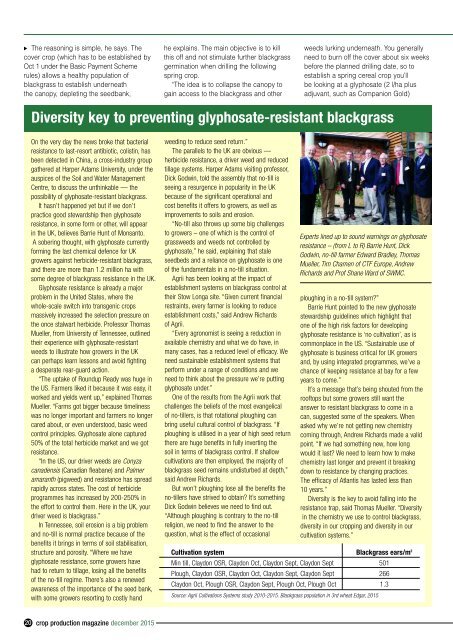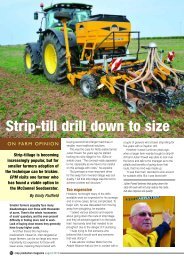You also want an ePaper? Increase the reach of your titles
YUMPU automatically turns print PDFs into web optimized ePapers that Google loves.
The reasoning is simple, he says. The<br />
cover crop (which has to be established by<br />
Oct 1 under the Basic Payment Scheme<br />
rules) allows a healthy population of<br />
blackgrass to establish underneath<br />
the canopy, depleting the seedbank,<br />
▲<br />
he explains. The main objective is to kill<br />
<strong>this</strong> off and not stimulate further blackgrass<br />
germination when drilling the following<br />
spring crop.<br />
“The idea is to collapse the canopy to<br />
gain access to the blackgrass and other<br />
weeds lurking underneath. You generally<br />
need to burn off the cover about six weeks<br />
before the planned drilling date, so to<br />
establish a spring cereal crop you’ll<br />
be looking at a glyphosate (2 l/ha plus<br />
adjuvant, such as Companion Gold)<br />
Diversity key to preventing glyphosate-resistant blackgrass<br />
On the very day the news broke that bacterial<br />
resistance to last-resort antibiotic, colistin, has<br />
been detected in China, a cross-industry group<br />
gathered at Harper Adams University, under the<br />
auspices of the Soil and Water Management<br />
Centre, to discuss the unthinkable –– the<br />
possibility of glyphosate-resistant blackgrass.<br />
It hasn’t happened yet but if we don’t<br />
practice good stewardship then glyphosate<br />
resistance, in some form or other, will appear<br />
in the UK, believes Barrie Hunt of Monsanto.<br />
A sobering thought, with glyphosate currently<br />
forming the last chemical defence for UK<br />
growers against herbicide-resistant blackgrass,<br />
and there are more than 1.2 million ha with<br />
some degree of blackgrass resistance in the UK.<br />
Glyphosate resistance is already a major<br />
problem in the United States, where the<br />
whole-scale switch into transgenic crops<br />
massively increased the selection pressure on<br />
the once stalwart herbicide. Professor Thomas<br />
Mueller, from University of Tennessee, outlined<br />
their experience with glyphosate-resistant<br />
weeds to illustrate how growers in the UK<br />
can perhaps learn lessons and avoid fighting<br />
a desperate rear-guard action.<br />
“The uptake of Roundup Ready was huge in<br />
the US. Farmers liked it because it was easy, it<br />
worked and yields went up,” explained Thomas<br />
Mueller. “Farms got bigger because timeliness<br />
was no longer important and farmers no longer<br />
cared about, or even understood, basic weed<br />
control principles. Glyphosate alone captured<br />
50% of the total herbicide market and we got<br />
resistance.<br />
“<strong>In</strong> the US, our driver weeds are Conyza<br />
canadensis (Canadian fleabane) and Palmer<br />
amaranth (pigweed) and resistance has spread<br />
rapidly across states. The cost of herbicide<br />
programmes has increased by 200-250% in<br />
the effort to control them. Here in the UK, your<br />
driver weed is blackgrass.”<br />
<strong>In</strong> Tennessee, soil erosion is a big problem<br />
and no-till is normal practice because of the<br />
benefits it brings in terms of soil stabilisation,<br />
structure and porosity. “Where we have<br />
glyphosate resistance, some growers have<br />
had to return to tillage, losing all the benefits<br />
of the no-till regime. There’s also a renewed<br />
awareness of the importance of the seed bank,<br />
with some growers resorting to costly hand<br />
weeding to reduce seed return.”<br />
The parallels to the UK are obvious ––<br />
herbicide resistance, a driver weed and reduced<br />
tillage systems. Harper Adams visiting professor,<br />
Dick Godwin, told the assembly that no-till is<br />
seeing a resurgence in popularity in the UK<br />
because of the significant operational and<br />
cost benefits it offers to growers, as well as<br />
improvements to soils and erosion.<br />
“No-till also throws up some big challenges<br />
to growers – one of which is the control of<br />
grassweeds and weeds not controlled by<br />
glyphosate,” he said, explaining that stale<br />
seedbeds and a reliance on glyphosate is one<br />
of the fundamentals in a no-till situation.<br />
Agrii has been looking at the impact of<br />
establishment systems on blackgrass control at<br />
their Stow Longa site. “Given current financial<br />
restraints, every farmer is looking to reduce<br />
establishment costs,” said Andrew Richards<br />
of Agrii.<br />
“Every agronomist is seeing a reduction in<br />
available chemistry and what we do have, in<br />
many cases, has a reduced level of efficacy. We<br />
need sustainable establishment systems that<br />
perform under a range of conditions and we<br />
need to think about the pressure we’re putting<br />
glyphosate under.”<br />
One of the results from the Agrii work that<br />
challenges the beliefs of the most evangelical<br />
of no-tillers, is that rotational ploughing can<br />
bring useful cultural control of blackgrass. “If<br />
ploughing is utilised in a year of high seed return<br />
there are huge benefits in fully inverting the<br />
soil in terms of blackgrass control. If shallow<br />
cultivations are then employed, the majority of<br />
blackgrass seed remains undisturbed at depth,”<br />
said Andrew Richards.<br />
But won’t ploughing lose all the benefits the<br />
no-tillers have strived to obtain? It’s something<br />
Dick Godwin believes we need to find out.<br />
“Although ploughing is contrary to the no-till<br />
religion, we need to find the answer to the<br />
question, what is the effect of occasional<br />
Experts lined up to sound warnings on glyphosate<br />
resistance – (from L to R) Barrie Hunt, Dick<br />
Godwin, no-till farmer Edward Bradley, Thomas<br />
Mueller, Tim Chamen of CTF Europe, Andrew<br />
Richards and Prof Shane Ward of SWMC.<br />
ploughing in a no-till system?”<br />
Barrie Hunt pointed to the new glyphosate<br />
stewardship guidelines which highlight that<br />
one of the high risk factors for developing<br />
glyphosate resistance is ‘no cultivation’, as is<br />
commonplace in the US. “Sustainable use of<br />
glyphosate is business critical for UK growers<br />
and, by using integrated programmes, we’ve a<br />
chance of keeping resistance at bay for a few<br />
years to come.”<br />
It’s a message that’s being shouted from the<br />
rooftops but some growers still want the<br />
answer to resistant blackgrass to come in a<br />
can, suggested some of the speakers. When<br />
asked why we’re not getting new chemistry<br />
coming through, Andrew Richards made a valid<br />
point. “If we had something new, how long<br />
would it last? We need to learn how to make<br />
chemistry last longer and prevent it breaking<br />
down to resistance by changing practices.<br />
The efficacy of Atlantis has lasted less than<br />
10 years.”<br />
Diversity is the key to avoid falling into the<br />
resistance trap, said Thomas Mueller. “Diversity<br />
in the chemistry we use to control blackgrass,<br />
diversity in our cropping and diversity in our<br />
cultivation systems.”<br />
Cultivation system Blackgrass ears/m 2<br />
Min till, Claydon OSR, Claydon Oct, Claydon Sept, Claydon Sept 501<br />
Plough, Claydon OSR, Claydon Oct, Claydon Sept, Claydon Sept 266<br />
Claydon Oct, Plough OSR, Claydon Sept, Plough Oct, Plough Oct 1.3<br />
Source: Agrii Cultivations Systems study 2010-2015. Blackgrass population in 3rd wheat Edgar, 2015<br />
20 crop production magazine december 2015



